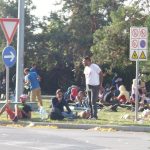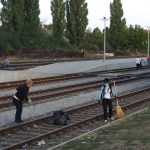The latest on the migrant crisis, as a second baby refugee is born in Croatia.
A Syrian baby, the ninth child of a woman from the war-torn country who has found herself at the winter transit centre in Slavonski Brod in Croatia, has been born in the local hospital, reports Vecernji List on November 6, 2015. “The birth has passed without problems, this is the mother’s ninth child”, Josip Barišić, head of the Obstetrics and Gynaecology Department, said. In the hospital, currently there are no other pregnant refugees, although there are some among the refugees who have arrived in the reception centre.
“The problem is that everybody wants to continue with their travel, so doctors and nurses perform only ‘semi-exams’. However, we are trying to help these people as best as we can”, Barišić said. An additional obstacle is the language barrier due to different languages and dialects spoken by refugees.
The first refugee baby was born at the beginning of October in Zagreb. Little Amal, which means “hope”, was given birth by a 17-year-old Syrian who went into labour while on the train from the transit centre in Opatovac. The police rushed her to a hospital in Zagreb.
From midnight to 9 pm on Thursday, 5,587 migrants and refugees entered Croatia. There are currently 2,219 migrants accommodated in the winter transit centre in Slavonski Brod. Since the beginning of the refugee crisis, 330,321 migrants have entered Croatia.
Croatian Interior Minister Ranko Ostojić gave an interview to Deutsche Welle in which he discussed co-operation with outer countries, the relations with Budapest, and the possible routes through Bosnia.
“In order to treat the refugees as humanely as possible, we have moved them to the winter transit centre, which has capacity for 5,000 people, just like Opatovac. The new location is better for winter conditions and allows a relatively rapid transit. These are commitments that have been agreed in Brussels during the meeting of leaders of countries which are on the Western Balkan migrant route. Croatia is one of the first which has fulfilled its obligations; we have a temporary refuge where people can refresh and move on. Hot spots will be created only in Greece. According to the protocol agreed with Serbia, the people go directly from Šid to Slavonski Brod, and then continue to Dobova in Slovenia. The system must start functioning in Greece. It is a Schengen country and should perform a complete registration process in accordance with the conventions and rules. In Slavonski Brod, we are doing the full registration process, but do are not sending the data forward. When it starts functioning in Greece, then Croatia will also send its information to Eurodac. To date, more than 320,000 people have passed through our country. The costs for Croatia are at least 2 million kuna a day. Up to this point, we have not received one cent of European aid. Everything is being paid by our taxpayers”, said Ostojić.
“Relations with Serbia and not idyllic now, but they are better. At the beginning, we insisted that the Serbian police should control the corridor for refugees. The situation has significantly improved after the protocol was agreed between the two police forces, so the influx of refugees to Croatia is now under control. As far as Slovenia is concerned, barbed wire is a waste of money. If you do not make a decision to shoot at people, no wires will help you. The Slovenians can put up walls, wires, fences, everything else, but until they take responsibility as a European country to shoot at those who cross the border, it is futile. Slovenians say they do not like my advice, but in the end they are doing what we had suggested to them at the very beginning. To limit the number of refugees to 2,500 people a day was impossible, especially since there was no reason. They themselves had created the chaos. Austria and Germany have denied that they have introduced any limitations. It is important that transit of refugees is continuing”, Ostojić said.
“The migrant crisis has led to tensions in inter-state relations; wire fences, army on the border between Hungary and Croatia, blockade of Serbia, the Serbian response to Croatia and then Slovenian response. And what if the route goes to Bosnia? That could bring additional instability. This is a turbulent area and there are a lot of those who prefer chaos. The route through Bosnia would be problematic given the capacities that Bosnia and Herzegovina has. BiH has enough of its own problems. Try to imagine BiH with wire fences between the cantons. But, let’s go back to the beginning. Jordan, Lebanon and Turkey should be given money to maintain the hot spots. When we stop the inflow, we will not have any problems”, Ostojić concluded.









